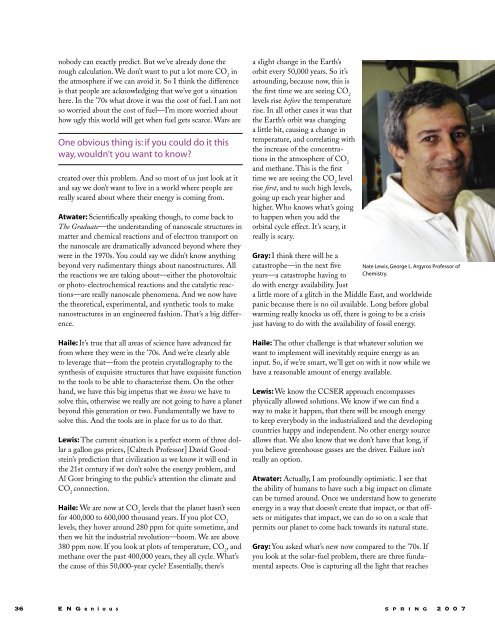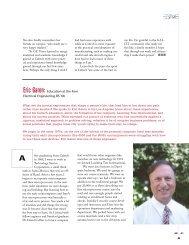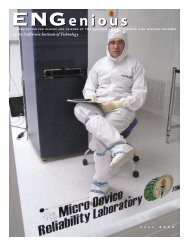Issue No.6 PDF (3 MB) - Division of Engineering and Applied Science
Issue No.6 PDF (3 MB) - Division of Engineering and Applied Science
Issue No.6 PDF (3 MB) - Division of Engineering and Applied Science
Create successful ePaper yourself
Turn your PDF publications into a flip-book with our unique Google optimized e-Paper software.
nobody can exactly predict. But we’ve already done the<br />
rough calculation. We don’t want to put a lot more CO 2<br />
in<br />
the atmosphere if we can avoid it. So I think the difference<br />
is that people are acknowledging that we’ve got a situation<br />
here. In the ’70s what drove it was the cost <strong>of</strong> fuel. I am not<br />
so worried about the cost <strong>of</strong> fuel—I’m more worried about<br />
how ugly this world will get when fuel gets scarce. Wars are<br />
One obvious thing is: if you could do it this<br />
way, wouldn’t you want to know<br />
created over this problem. And so most <strong>of</strong> us just look at it<br />
<strong>and</strong> say we don’t want to live in a world where people are<br />
really scared about where their energy is coming from.<br />
Atwater: Scientifically speaking though, to come back to<br />
The Graduate—the underst<strong>and</strong>ing <strong>of</strong> nanoscale structures in<br />
matter <strong>and</strong> chemical reactions <strong>and</strong> <strong>of</strong> electron transport on<br />
the nanoscale are dramatically advanced beyond where they<br />
were in the 1970s. You could say we didn’t know anything<br />
beyond very rudimentary things about nanostructures. All<br />
the reactions we are taking about—either the photovoltaic<br />
or photo-electrochemical reactions <strong>and</strong> the catalytic reactions—are<br />
really nanoscale phenomena. And we now have<br />
the theoretical, experimental, <strong>and</strong> synthetic tools to make<br />
nanostructures in an engineered fashion. That’s a big difference.<br />
Haile: It’s true that all areas <strong>of</strong> science have advanced far<br />
from where they were in the ’70s. And we’re clearly able<br />
to leverage that—from the protein crystallography to the<br />
synthesis <strong>of</strong> exquisite structures that have exquisite function<br />
to the tools to be able to characterize them. On the other<br />
h<strong>and</strong>, we have this big impetus that we know we have to<br />
solve this, otherwise we really are not going to have a planet<br />
beyond this generation or two. Fundamentally we have to<br />
solve this. And the tools are in place for us to do that.<br />
Lewis: The current situation is a perfect storm <strong>of</strong> three dollar<br />
a gallon gas prices, [Caltech Pr<strong>of</strong>essor] David Goodstein’s<br />
prediction that civilization as we know it will end in<br />
the 21st century if we don’t solve the energy problem, <strong>and</strong><br />
Al Gore bringing to the public’s attention the climate <strong>and</strong><br />
CO 2<br />
connection.<br />
Haile: We are now at CO 2<br />
levels that the planet hasn’t seen<br />
for 400,000 to 600,000 thous<strong>and</strong> years. If you plot CO 2<br />
levels, they hover around 280 ppm for quite sometime, <strong>and</strong><br />
then we hit the industrial revolution—boom. We are above<br />
380 ppm now. If you look at plots <strong>of</strong> temperature, CO 2<br />
, <strong>and</strong><br />
methane over the past 400,000 years, they all cycle. What’s<br />
the cause <strong>of</strong> this 50,000-year cycle Essentially, there’s<br />
a slight change in the Earth’s<br />
orbit every 50,000 years. So it’s<br />
astounding, because now, this is<br />
the first time we are seeing CO 2<br />
levels rise before the temperature<br />
rise. In all other cases it was that<br />
the Earth’s orbit was changing<br />
a little bit, causing a change in<br />
temperature, <strong>and</strong> correlating with<br />
the increase <strong>of</strong> the concentrations<br />
in the atmosphere <strong>of</strong> CO 2<br />
<strong>and</strong> methane. This is the first<br />
time we are seeing the CO 2<br />
level<br />
rise first, <strong>and</strong> to such high levels,<br />
going up each year higher <strong>and</strong><br />
higher. Who knows what’s going<br />
to happen when you add the<br />
orbital cycle effect. It’s scary, it<br />
really is scary.<br />
Gray: I think there will be a<br />
catastrophe—in the next five<br />
years—a catastrophe having to<br />
do with energy availability. Just<br />
Nate Lewis, George L. Argyros Pr<strong>of</strong>essor <strong>of</strong><br />
Chemistry.<br />
a little more <strong>of</strong> a glitch in the Middle East, <strong>and</strong> worldwide<br />
panic because there is no oil available. Long before global<br />
warming really knocks us <strong>of</strong>f, there is going to be a crisis<br />
just having to do with the availability <strong>of</strong> fossil energy.<br />
Haile: The other challenge is that whatever solution we<br />
want to implement will inevitably require energy as an<br />
input. So, if we’re smart, we’ll get on with it now while we<br />
have a reasonable amount <strong>of</strong> energy available.<br />
Lewis: We know the CCSER approach encompasses<br />
physically allowed solutions. We know if we can find a<br />
way to make it happen, that there will be enough energy<br />
to keep everybody in the industrialized <strong>and</strong> the developing<br />
countries happy <strong>and</strong> independent. No other energy source<br />
allows that. We also know that we don’t have that long, if<br />
you believe greenhouse gasses are the driver. Failure isn’t<br />
really an option.<br />
Atwater: Actually, I am pr<strong>of</strong>oundly optimistic. I see that<br />
the ability <strong>of</strong> humans to have such a big impact on climate<br />
can be turned around. Once we underst<strong>and</strong> how to generate<br />
energy in a way that doesn’t create that impact, or that <strong>of</strong>fsets<br />
or mitigates that impact, we can do so on a scale that<br />
permits our planet to come back towards its natural state.<br />
Gray: You asked what’s new now compared to the ’70s. If<br />
you look at the solar-fuel problem, there are three fundamental<br />
aspects. One is capturing all the light that reaches<br />
36 E N G e n i o u s s p r i n g 2 0 0 7







